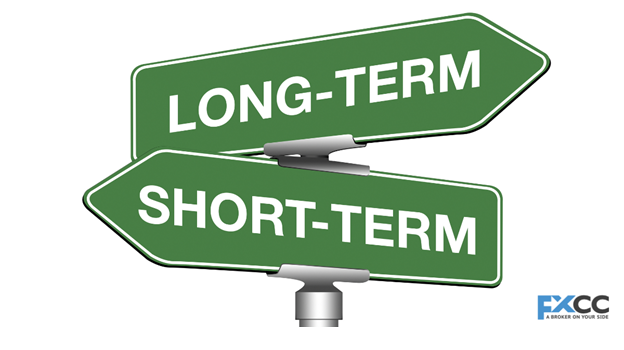
In the dynamic world of Forex trading, choosing between short-term and long-term strategies is a crucial decision for traders aiming to succeed. In this comprehensive guide, we’ll take an in-depth look at both long-term and short-term trading strategies, examining their respective advantages, disadvantages, and considerations. By the end, you’ll have a clearer understanding of which strategy suits your goals and preferences best, empowering you to trade with confidence and achieve your desired outcomes. Let’s dive deep into both options to help you navigate this complex terrain and find the best fit for your trading journey.
Long-Term Trading: Riding the Waves
Long-term trading is like surfing the market waves – you hold onto your investments for a long time, maybe even for months or years. It’s great because it helps you avoid stress from daily market ups and downs. Instead, you focus on catching big trends that can make you lots of money over time.

But, it’s not all smooth sailing. You need a lot of patience because it can take a while for your investments to pay off. Plus, you have to be ready for market ups and downs and be okay with setbacks along the way.
Long-Term Trading Benefits
Long-term trading is like sailing on a sturdy ship, cruising confidently through market waves. It involves holding onto investments for extended periods, from weeks to years. One big perk is reduced stress – traders can relax, knowing they don’t have to worry about daily market fluctuations. Instead, they focus on catching significant trends that lead to substantial profits over time.
Challenges of Long-Term Trading
Despite its perks, long-term trading isn’t all smooth sailing. It requires patience, akin to waiting for the tide to turn. It may take time for investments to pay off, testing traders’ resolve. Moreover, traders must be ready to navigate stormy market conditions and endure temporary setbacks.
Short-Term Trading: Navigating Choppy Waters
On the flip side, short-term trading is like navigating choppy waters. This strategy involves executing trades within shorter time frames, often days, hours, or even minutes. Short-term traders thrive on capitalizing on small price movements, which can lead to rapid profit accumulation. They also benefit from increased liquidity and flexibility in their trading approach.
However, short-term trading comes with its own set of challenges. Constant monitoring of the market is necessary, as price movements can occur swiftly and unexpectedly. Moreover, short-term traders may find themselves susceptible to market noise and emotional trading decisions.

Factors to Consider
When deciding between long-term and short-term trading, several factors come into play. Consider your risk tolerance, time availability, trading style, and current market conditions. It’s crucial to evaluate these factors carefully and align your chosen strategy with your overall objectives and preferences.
Making Your Decision
Ultimately, the decision between long-term and short-term trading hinges on your unique circumstances and goals. Take the time to assess your risk tolerance, time commitments, and trading preferences. Remember, there’s no one-size-fits-all solution, and the best strategy is one that aligns with your individual needs and objectives.
Conclusion: Navigating Your Trading Journey
In conclusion, the choice between long-term and short-term trading is a significant decision that can profoundly impact your success in the forex market. By understanding the benefits, drawbacks, and considerations of each approach, you’ll be better equipped to make an informed decision that aligns with your trading objectives. Whether you choose the patient approach of long-term trading or the agility of short-term trading, remember to stay disciplined, manage risk effectively, and adapt to changing market conditions.
FAQs:
What’s the difference between long-term and short-term trading?
Long-term trading involves holding positions for extended periods, while short-term trading involves executing trades within shorter time frames.
How do I determine which trading strategy is right for me?
Consider factors such as your risk tolerance, time availability, trading style, and current market conditions when choosing between long-term and short-term trading.
Can I switch between long-term and short-term trading?
Yes, traders can switch between long-term and short-term trading strategies based on their preferences, market conditions, and trading goals.
Are there any specific indicators or tools recommended for each strategy?
For long-term trading, indicators such as moving averages and trend lines may be useful. For short-term trading, tools like stochastic oscillators and Bollinger Bands can be helpful.
How do I manage risk when trading in either the long-term or short-term?
Risk management is crucial in both long-term and short-term trading. Implement strategies such as setting stop-loss orders, diversifying your portfolio, and practicing disciplined trading habits to manage risk effectively.

